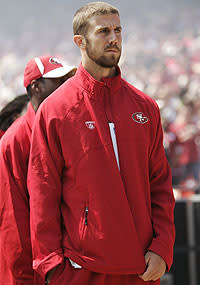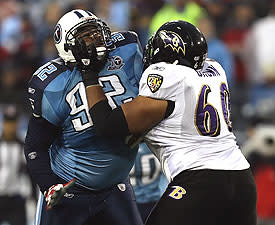Later picks often ignored in rookie salary debate
As the annual discussion over high-end rookie contracts is again about to take center stage, consider the cases of San Francisco 49ers quarterback Alex Smith and St. Louis Rams guard Jason Brown.
Smith, the No. 1 overall NFL draft pick in 2005, was supposed to rebuild the 49ers' passing legacy that has crumbled since Jeff Garcia appeared in three straight Pro Bowls earlier this decade. After being drafted, Smith was given a six-year deal that included $24 million guaranteed.

Smith was a bystander all of 2008.
(Paul Sakuma/AP Photo)
Four years later, Smith has been a bust, an example given by top team executives, fans and even some veteran players of the wasted money paid to top rookies. Worse, his contract is a key stepping stone to the strong possibility that the No. 1 pick in this year's draft may become only the second player in league history to get $40 million guaranteed. Pro Bowl defensive tackle Albert Haynesworth was the first player to do that when he signed with the Washington Redskins in February.
Then there is the case of Brown, a fourth-round pick by the Baltimore Ravens in '05 – the 124th player selected. With the Ravens, Brown became a full-time starter in his second season, played both center and guard, started 44 of 48 regular-season games over the past three years and is considered one of the top interior offensive linemen in the game.
During Brown's four seasons in Baltimore, he made a grand total of $2.741 million. While no one in the general public is crying tears over Brown's plight (particularly after he signed a five-year, $37.5 million contract with the Rams in February), the fact is that Brown's combined income as he developed into one of the top players in the game couldn't pay Smith's California state income tax.
In short, the NFL's salary scale for rookies is broken with the top handful of picks gobbling up huge sums while the vast majority of young players toil for much less.
"Is the system out of whack?" asked agent Tom Condon, who along with partner Ben Dogra of Creative Artists Agency represents recent top-5 picks Smith, Mario Williams, Jake Long and Matt Ryan. "I can't sit here and tell you it's not. But, by the same token, it's out of whack at the other end. When teams misevaluate a guy like Jason Brown and he ends up in the fourth round, then he becomes one of the best players in the league, there should be a way for him to make some more money."
Condon and Dogra, who represent 10 players that have been projected by various analysts to go in the first round of this year's draft, have struck gold with top draft talent in the past four years. Smith, Williams ('06) and Long ('08) were No. 1 overall picks in three of the past four years. Ryan was the No. 3 overall pick last season and received a six-year deal that featured a rookie-record $34.75 million in guaranteed money (Long got $30 million guaranteed over five years as the No. 1 overall pick).
Yet, during public discussion over the NFL's rookie wage system, little attention is paid to the flip side. Miami Dolphins linebacker Channing Crowder (three years, $13.8 million) and Ravens cornerback Domonique Foxworth (four years, $28 million) cashed in this year after each commanded well under $3 million during their initial pacts as third-round picks in the '05 draft.
Even more, overall rookie pay has decreased from 7 percent in 1995 to 4 percent in 2008, according to a study commissioned by the NFL Players Association.
"What the owners claim is a problem is really not an issue," NFLPA attorney Richard Berthelsen said. "The rookies aren't making money at the expense of the veterans. What's really happening is that the top rookies are taking money away from the ones at the bottom."
Still, beginning last May when the NFL owners opted out of the collective bargaining agreement, the league and commissioner Roger Goodell made it clear that they wanted a change in the rookie pay system. However, what they want it to be isn't clear.
"That's a matter of collective bargaining by people who are much smarter than me when it comes to that type of stuff," Indianapolis Colts president Bill Polian said.
The reality is that the rookie pay system, which includes a cap on rookie salaries within the overall salary cap, works exceptionally well for most NFL teams. It allows them to stock their rosters with players who are relatively cheap compared to veterans who have hit free agency or have signed contract extensions.

Brown, right, battled Haynesworth in the playoffs.
(Jonathan Daniel/Getty)
"It's a lot different for those guys who aren't one of the top five or six taken," said agent Harold Lewis, who negotiated the deal that made Brown the highest paid interior offensive lineman in the game. "For most guys, you're doing everything you can to play well and get to that unrestricted year to get as much leverage as you can."
Additionally, the NFL and NFLPA have created a system that almost forces the top picks to get inordinate amounts of money from the rookie cap. The top 16 picks in the first round can be signed to six-year contracts and the highest picks are often given the longest contracts because they are viewed as potential cornerstone players. The bottom 16 picks of the first round can be signed to five-year maximum contracts. After the first round, the maximum contract for a player is four years.
The NFL Players Association requested the four-year max after the first round because the union felt that far too many rookies were signing long-term deals that prevented them from ever becoming unrestricted free agents.
While the league and union have created a formula for contracts, there's obviously no way to guarantee success rates among the players. Again, the 2005 draft is a prime example.
Aside from Smith at No. 1, the top 10 picks were a wasteland. Running back Cedric Benson was taken No. 4 overall by the Chicago Bears, cornerback Pacman Jones was taken No. 6 by the Tennessee Titans, wide receiver Troy Williamson went No. 7 to the Minnesota Vikings and wide receiver Mike Williams went No. 10 to the Detroit Lions. Only Smith is still with the team that drafted him while Benson, Jones and Williams have all been cut at least once. Jones and Williams are out of football.
That doesn't account for No. 5 overall pick Carnell "Cadillac" Williams, the running back from the Tampa Bay Buccaneers who has played in only 10 games over the past two years because of injuries. The remaining picks in the top 10 that year were running back Ronnie Brown at No. 2, wide receiver Braylon Edwards at No. 3, cornerback/safety Antrel Rolle at No. 8 and cornerback Carlos Rogers at No. 9. That's not exactly a treasure trove of players. Conversely, the fourth round featured not only Brown, but also running backs Brandon Jacobs and Marion Barber, quarterback Kyle Orton and safety Kerry Rhodes.
"Look, we're no different than human resource people in most businesses," Polian said. "If we're right on half the people we hire, we're doing well."
Not every team executive agrees with that viewpoint.
"You want a reason why we should have a wage scale, that draft is it," the executive said.
The issue is what the NFL is willing to give to get what it wants. In short, players can't be expected to sign six-year contracts and take less money.
Thus, the easiest solution is to make all rookie contracts shorter. Shorter contracts means less guaranteed money for bust players such as Smith. It also allows good players who went later in the draft, such as Brown, to get to free agency faster.
"Really, this shouldn't be that hard to fix," Condon said. "You could probably sit down and hammer it out pretty quick if the league really wanted to."
